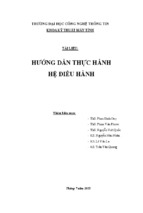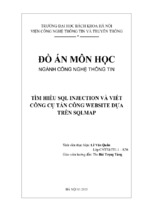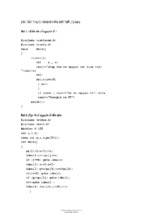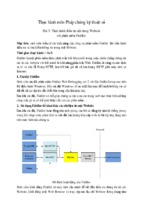Mô tả:
Cable Networks
Chapter 7
Cable Networks
Korea-Vietnam Friendship IT College
Cable Networks
Overview
•
•
•
•
•
Introduction
Technical basics and Standards
Wireline cable network transmission
Cable network architecture
Cable network protocols
2
Korea-Vietnam Friendship IT College
Cable Networks
Introduction
• Initially, cable systems re-transmitted broadcast
television signals.
• 1980s, upgraded to an HFC (Hybrid Optical Fiber
Coaxial Cable) infrastructure
– to support delivery of additional cable television programs and
enable improvements in signal quality by reducing line noise
and signal attenuation.
• By the turn of the century, wireline and wireless cable
networks routinely facilitated access to voice, video, and
data services and interactive broadband applications in
fields
– such as tele-education, telemedicine, E-business, and teleentertainment.
3
Korea-Vietnam Friendship IT College
Cable Networks
Technical Basics and Standards
•
•
•
•
Cable modem & operations
CMTS
Headend equipement
Standards
4
Korea-Vietnam Friendship IT College
Cable Networks
Cable Modem
Cable modems perform conventional signal modulation and
demodulation operations at the subscriber premise for enabling voice,
video, and data transport via a cable network.
5
Korea-Vietnam Friendship IT College
Cable Networks
Cable Modem
• In terms of operations, the cable modem is attached to
the subscriber PC for enabling connectivity via coaxial
cable or the upgraded HFC infrastructure to the CMTS
(Cable Modem Termination System).
• The CMTS is located at the local cable operator facility.
• Headend or distribution hub supports downstream
transmissions over the local loop from the CMTS at the
local cable operator facility to the subscriber premise
over the local loop.
6
Korea-Vietnam Friendship IT College
Cable Networks
Cable Modem Operation
Cable modems are constantly on, thereby eliminating the need for
redialing to reestablish connectivity to cable provider services. As
with cable modems, STBs enable e-mail, IP telephony, encryption,
Web browsing, and connectivity to broadband services.
7
Korea-Vietnam Friendship IT College
Cable Networks
Cable Modem Operation
A typical home-based cable network configuration.
8
Korea-Vietnam Friendship IT College
Cable Networks
CMTS
•The CMTS performs an array of gateway, server, routing,
management, and security functions to ensure trouble-free voice,
video, and data transport.
•The CMTS also processes billing information and tracks network
usage.
9
Korea-Vietnam Friendship IT College
Cable Networks
CMTS (2)
• On the downstream path
– a DOCSIS-certified CMTS amplifies, transforms, processes,
and routes data via trunks and feeder cables from the NSP
(Network Service Provider) to the subscriber PC based on the
subscriber IP address.
• On the upstream or return path
– Data are transported from the subscriber PC cable modem via
feeder cables and trunks to the CMTS at the local cable
operator facility.
– The CMTS routes subscriber data to the NSP for transport to
networks such as the Internet, extranets, and intranets,
depending on the destination address.
10
Korea-Vietnam Friendship IT College
Cable Networks
Headend equipment
• Also called a distribution hub, headend equipment
inserts voice, video, and data signals for transmission in
the downstream direction or from the cable network to
the subscriber premise.
• Headend equipment is situated next to the CMTS.
11
Korea-Vietnam Friendship IT College
Cable Networks
Standards
•
•
•
•
•
•
•
•
Cable Broadband Forum
ETSI
ITU-T
IETF
MPEG
NCTA
WCA
W3C
12
Korea-Vietnam Friendship IT College
Cable Networks
Wireline Cable Network Transmission
• Asymmetric cable transmission solutions remain popular
in the present-day environment
– Typically, downstream rates at 27 Mbps and upstream rates at
10 Mbps are supported by the HFC platform.
– Transmission rate limits by the 10BASE-T Ethernet NIC
(Network Interface Card).
• Affected by
– amount of traffic on the neighborhood cable network segment,
– quantity of shared bandwidth,
– the age and condition of the HFC plant or the coaxial cable
wiring, faulty connections, and impulse noise generated by
household appliances.
13
Korea-Vietnam Friendship IT College
Cable Networks
Hybrid Optical Fiber Coaxial Cable (HFC)
To promote high-speed one-way or equivalent speeds in both
directions, replaced large segments of in-place coaxial cable with
higher-capacity optical fiber.
14
Korea-Vietnam Friendship IT College
Cable Networks
Cable Network Protocols
•
•
•
•
TDMA (Time-division Multiple Access)
FDMA (Frequency-division Multiple Access)
CDMA (Code-Division Multiple Access)
QPSK (Quadrature Phase Shift Key) and QAM
(Quadrature Amplitude Modulation)
• OFDM (Orthogonal Frequency-Division Multiple
Access)
15
Korea-Vietnam Friendship IT College
Cable Networks
Cable Network Architecture
• Physical layer
– Upstream and downstream data channels
• Data Link layer
– employ the Medium Access Control (MAC) protocol to
facilitate collision detection and retransmission, error detection
and error recovery, and timing and synchronization functions.
• Network layer
– Wireline cable: transmission of IP (Internet Protocol) packets
via the HFC infrastructure.
– Wireless cable: support transmission of IP packets as
electromagnetic signals through free space.
16
Korea-Vietnam Friendship IT College
Cable Networks
Cable Network Architecture (2)
• Transport layer
– operate in conjunction with the UDP and the TCP.
• Upper layers
– Employ SNMPv3 (Simple Network Management Protocol
version 3) for managing and administering network operations.
17
Korea-Vietnam Friendship IT College
Cable Networks
Summary
18
Korea-Vietnam Friendship IT College
- Xem thêm -




















